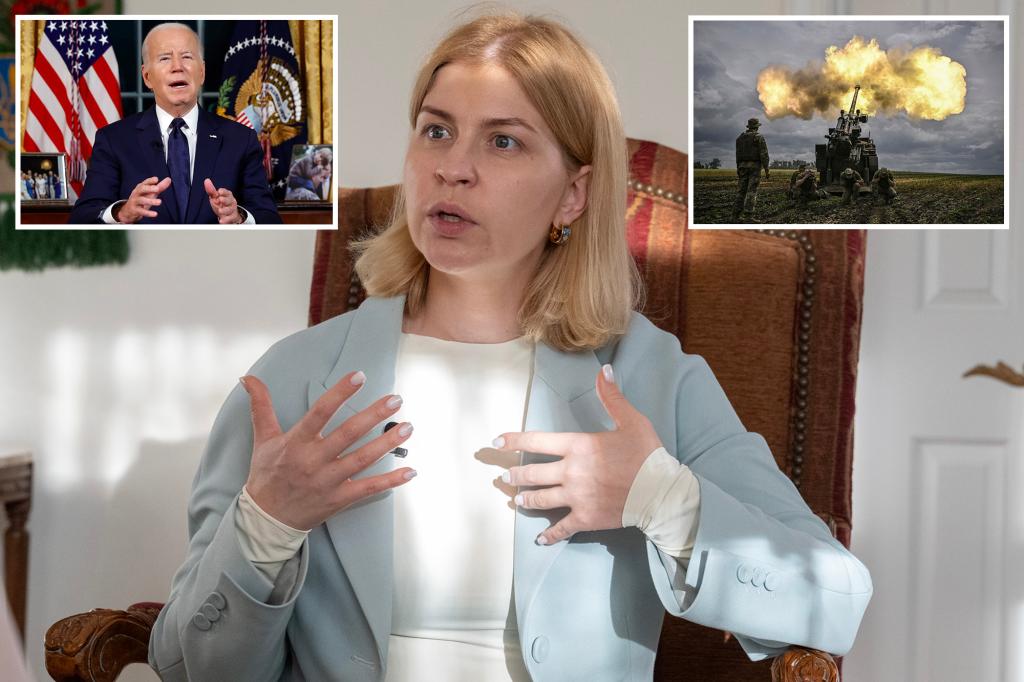WASHINGTON — Ukraine’s new ambassador to the US said Kyiv and Washington “understand each other much better” with President Trump in the White House — and is optimistic that an end to the bloody war could soon be a reality.
In her first interview since taking office, Amb. Olha Stefanishyna told The Post that Kyiv now has a clear plan to end the war with Russia after months of dogged behind-the-scenes coordination with the Trump administration.
“After all of these months of discussions, we know how to do it — and we just have to do it,” Stefanishyna said.
Stefanishyna, who arrived in Washington just days before the United Nations General Assembly late last month, said the strategy emerging between Ukraine, the US and European allies is far broader than traditional diplomacy.
It’s about building self-sustaining defense, securing enforceable peace guarantees, and creating lasting economic partnerships — all designed to make “ending the war” a reality, not just a slogan.
Ending — not sustaining — the war
Stefanishyna made clear that under Trump, the US and Ukraine are aligning around a new philosophy.
“The first principle is that the goal is a just peace. The second is that we are speaking about ending the war — not keeping Ukraine fighting. This is a huge difference,” she said.
The ambassador drew a contrast between this approach and that of the prior US administration, which she said focused more on sustaining Ukraine’s battlefield resistance rather than charting an exit from the war.
“When we speak about ‘keeping Ukraine in the fight,’ it meant constantly debating which types of weapons could be provided — instead of ensuring Ukraine is capable of defending itself and saving its forces,” Stefanishyna said.
“Now, when we’re speaking about ending the war, it’s a different reality.”
Central to this new approach, she said, is building Ukraine’s long-term defense capacity through direct procurement from US and allied defense industries — a fundamental change from earlier forms of military aid.
“Now we’re speaking about the ability to procure military equipment from the U.S. and other allies,” Stefanishyna explained. “That means the US and NATO command identify the priorities on the battlefield — and it’s procured strategically, based on needs. It’s much more structured.”
She noted that this structure represents “a fundamentally different process” that not only strengthens Ukraine but bolsters NATO’s collective defense.
Time and again, former President Joe Biden’s administration hemmed and hawed over what weapons to send Ukraine – often taking too long for approvals out of a pervasive fear of escalation, defense analysts have said. Trump’s approach allows Ukraine and European partners more agency in their own defense.
The new system allows Ukraine to plan, prioritize, and co-develop weapons tailored to its defense — a shift she described as “a major step toward independence and victory.”
Partnerships over dependency
Stefanishyna pointed to a series of joint US-Ukraine initiatives — including a new mineral deal and an upcoming drone manufacturing agreement — as examples of how security and economic strategy now work hand-in-hand under the burgeoning Trump-Zelensky relationship.
“These partnerships are part of ending the war,” she said. “It’s not just going to be an agreement signed somewhere — it’s building the different pieces that make peace possible.”
The mineral deal has already led to the creation of a Ukraine Recovery and Reconstruction Fund, she said, while the drone initiative aims to expand joint production of advanced systems that will make Ukraine’s military “more self-reliant, more precise, and more capable.”
The ambassador said the new alignment between Washington, Kyiv, and European allies has given her confidence that peace is within reach.
“Security guarantees must be something solid, enforceable — and they should happen before any talks with the aggressor,” she said, describing the framework now being built with Trump’s support.
She emphasized that the West’s goal is not to prolong fighting, but to make it unsustainable for Russia to continue waging war.
“History is repeating itself,” Stefanishyna said. “The Soviet Union collapsed because being the Soviet Union was too expensive. The pressure was too high to fuel all the propaganda and military machines. That playbook is still there. Russia is big, but not that big — and all its secrets are no longer secrets.”
Stefanishyna credited President Trump with having “a better understanding” of the situation on the ground than many realize — and with pushing for a results-driven approach that favors leverage over endless negotiation.
“We’re at a moment when the US and Ukraine understand each other much better,” she said. “President Trump knows what’s happening on the battlefield and what needs to happen to end the killing.”
Beyond military and diplomatic ties, Stefanishyna said Ukraine intends to share what it’s learned from the war to strengthen both the United States and NATO.
“We want to give back our knowledge and capabilities to strengthen America and the Alliance,” she said. “That’s the kind of partnership that brings peace — one built not on dependency, but on mutual strength.”
For Stefanishyna, the mission is deeply personal — and political.
“Whatever we can do as a country, and I can do as ambassador, to serve this purpose — to bring a just peace to my land and to help President Trump deliver on his promise — is more than important for my country,” she said. “And for me, as an ambassador.”
Read the full article here

